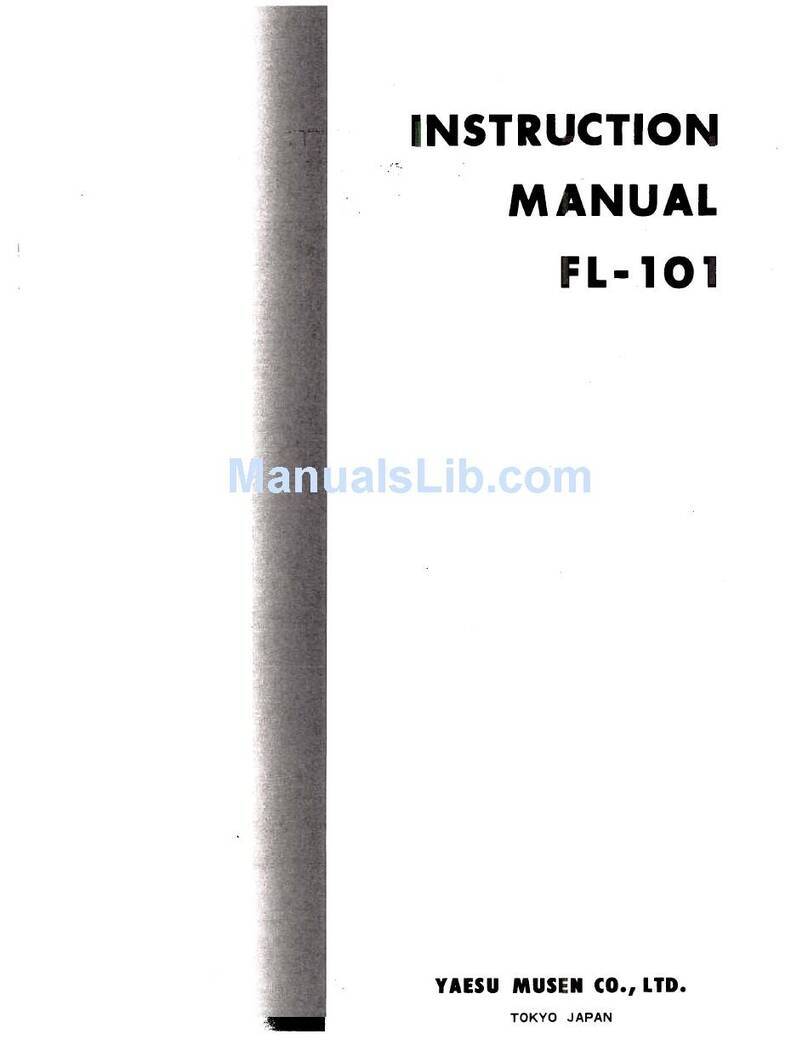
Alignment
The VX-4000 has been carefully aligned at the factory
for the specified performance across the frequency range
specified for each version.
Realignment should therefore not be necessary except
in the event of a component failure, or alteration of
version. All component replacement and service should
be performed only by an authorized Yaesu representative,
or the warranty policy may be voided.
The following procedures cover the sometimes critical
and tedious adjustments that are not normally required
once the transceiver has left the factory. However, if
damage occurs and some parts are replaced,
realignment may be required. If a sudden problem occurs
during normal operation, it is likely due to component
failure; realignment should not be done until after the
faulty component has been replaced.
We recommend that servicing be performed only by
authorized Yaesu service technicians who are
experienced with the circuitry and fully equipped for
repair and alignment. Therefore, if a fault is suspected,
contact the dealer from whom the transceiver was
purchased for instructions regarding repair.
Authorized Yaesu service technicians realign all circuits
and make complete performance checks to ensure
compliance with factory specifications after replacing any
faulty components. Those who do undertake any of the
following alignments are cautioned to proceed at their
own risk. Problems caused by unauthorized attempts at
realignment are not covered by the warranty policy. Also,
Yaesu must reserve the right to change circuits and
alignment procedures in the interest of improved
performance, without notifying owners. Under no
circumstances should any alignment be attempted unless
the normal function and operation of the transceiver are
clearly understood, the cause of the malfunction has
been clearly pinpointed and any faulty components
replaced, and the need for realignment determined to be
absolutely necessary. The following test equipment
(and thorough familiarity with its correct use) is necessary
for complete realignment. Correction of problems caused
by misalignment resulting from use of improper test
equipment is not covered under the warranty policy.
While most steps do not require all of the equipment
listed, the interactions of some adjustments may require
that more complex adjustments be performed afterwards.
Do not attempt to perform only a single step unless it is
clearly isolated electrically from all other steps. Have all
test equipment ready before beginning, and follow all of
the steps in a section in the order presented.
Required Test Equipment
RF signal generator: calibrated output level at 1000 MHz
(0 dBµ =1.0 µV - closed circuit)
Deviation Meter (linear detector)
AF Millivoltmeter
SINAD Meter
Inline Wattmeter with 5% accuracy at 1000 MHz
Regulated DC Power Supply: adjustable from 10 to 17
VDC, 15A
50-ohm Non-reactive Dummy Load: 100W at 1000 MHz
Frequency Counter: >0.1 ppm accuracy at 1000 MHz
AF Signal Generator
DC Voltmeter: high impedance
RF Sampling Coupler(attenuation pad)
AF Dummy Load: 4 ohm, 20W
Oscilloscope
Spectrum Analyzer
IBM PC/compatible computer w/Yaesu CT-71
programming cable and CE-35 channel programming
editor.
50-ohms RF Signal
Dummy load Generator
RFSampling
Inline Wattmeter Coupler
Transceiver
DeviationMeter CT-70
CT-29 Connection
Frequency Cable Power Supply
Counter IBM PC 13.8V DC
COMport
Alignment Preparation & Precautions
A dummy load and inline wattmeter must be connected to
the main antenna jack in all procedures that call for
transmission, except where specified otherwise. Correct
alignment is not possible with an antenna. After
completing one step, read the following step to determine
whether the same test equipment will be required. If not,
remove the test equipment (except dummy load and
wattmeter, if connected) before proceeding.
Correct alignment requires that the ambient temperature
be the same as that of the transceiver and test
equipment, and that this temperature be held constant
between 20 and 30°C (68 86F). When the transceiver is
brought into the shop from hot or cold air it should be
allowed some time for thermal equalization with the
environment before alignment. If possible, alignments
should be made with oscillator shields and circuit boards
firmly affixed in place. Also, the test equipment must be
thoroughly warmed up before beginning.
Before beginning, connect the transceiver and PC using
the CT-71 programming cable as described in the
EEPROM Programming chapter, and download the
EEPROM data from the transceiver to the computer.
Store this data in a disk file so that it can be saved and
retrieved later. Using the table below, program the
channel, CTCSS, and DCS alignment settings for your
transceiver version. Upload this file to the transceiver.
Note: Signal levels in dB referred to in this procedure are
based on 0 dBm = 0.5 mV (closed circuit).
Caution: Do not connect this line to ground, and be
certain that the speaker has adequate capability to
handle the audio output from the radio.






















